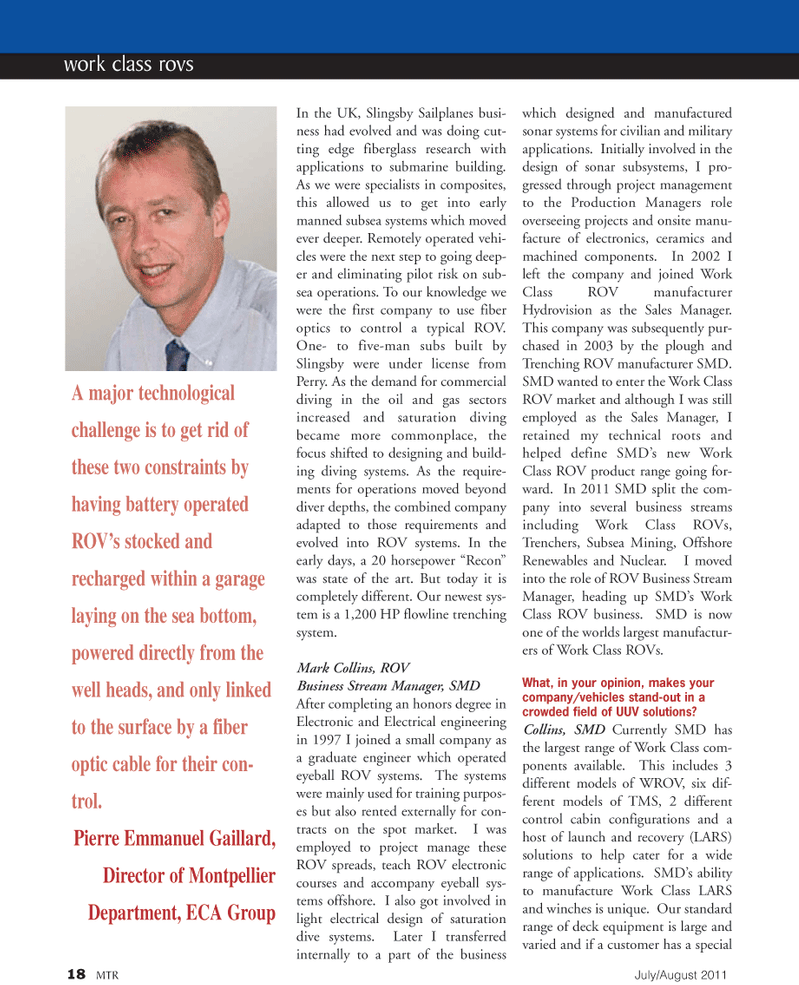
Page 18: of Marine Technology Magazine (July 2011)
MTR100 Edition
Read this page in Pdf, Flash or Html5 edition of July 2011 Marine Technology Magazine
In the UK, Slingsby Sailplanes busi- ness had evolved and was doing cut- ting edge fiberglass research with applications to submarine building.As we were specialists in composites, this allowed us to get into early manned subsea systems which moved ever deeper. Remotely operated vehi- cles were the next step to going deep- er and eliminating pilot risk on sub-sea operations. To our knowledge we were the first company to use fiber optics to control a typical ROV. One- to five-man subs built by Slingsby were under license from Perry. As the demand for commercial diving in the oil and gas sectorsincreased and saturation diving became more commonplace, the focus shifted to designing and build-ing diving systems. As the require- ments for operations moved beyond diver depths, the combined company adapted to those requirements and evolved into ROV systems. In the early days, a 20 horsepower Recon? was state of the art. But today it is completely different. Our newest sys- tem is a 1,200 HP flowline trenching system.Mark Collins, ROV Business Stream Manager, SMD After completing an honors degree in Electronic and Electrical engineering in 1997 I joined a small company asa graduate engineer which operatedeyeball ROV systems. The systems were mainly used for training purpos- es but also rented externally for con- tracts on the spot market. I was employed to project manage these ROV spreads, teach ROV electronic courses and accompany eyeball sys- tems offshore. I also got involved in light electrical design of saturationdive systems. Later I transferred internally to a part of the business which designed and manufactured sonar systems for civilian and military applications. Initially involved in the design of sonar subsystems, I pro- gressed through project management to the Production Managers role overseeing projects and onsite manu- facture of electronics, ceramics and machined components. In 2002 I left the company and joined Work Class ROV manufacturer Hydrovision as the Sales Manager. This company was subsequently pur-chased in 2003 by the plough and Trenching ROV manufacturer SMD. SMD wanted to enter the Work Class ROV market and although I was still employed as the Sales Manager, I retained my technical roots and helped define SMDs new Work Class ROV product range going for- ward. In 2011 SMD split the com- pany into several business streams including Work Class ROVs, Trenchers, Subsea Mining, Offshore Renewables and Nuclear. I moved into the role of ROV Business Stream Manager, heading up SMDs Work Class ROV business. SMD is now one of the worlds largest manufactur-ers of Work Class ROVs. What, in your opinion, makes yourcompany/vehicles stand-out in acrowded field of UUV solutions? Collins, SMD Currently SMD has the largest range of Work Class com- ponents available. This includes 3 different models of WROV, six dif- ferent models of TMS, 2 different control cabin configurations and a host of launch and recovery (LARS) solutions to help cater for a widerange of applications. SMDs ability to manufacture Work Class LARS and winches is unique. Our standard range of deck equipment is large andvaried and if a customer has a special 18MTRJuly/August2011 work class rovs A major technologicalchallenge is to get rid ofthese two constraints by having battery operated ROVs stocked and recharged within a garage laying on the sea bottom,powered directly from the well heads, and only linked to the surface by a fiber optic cable for their con- trol. Pierre Emmanuel Gaillard, Director of Montpellier Department, ECA Group

 17
17

 19
19
